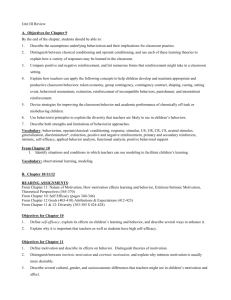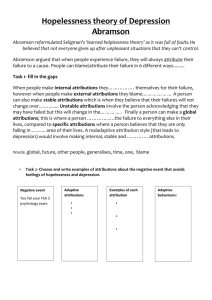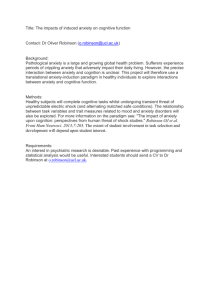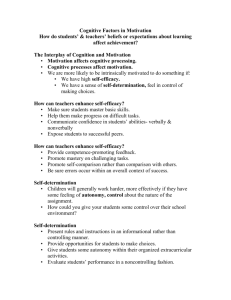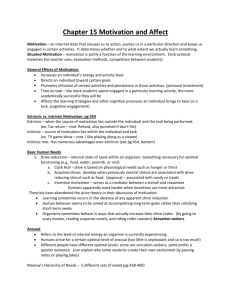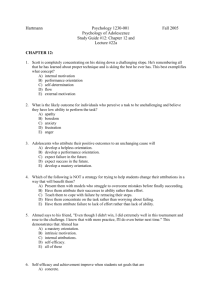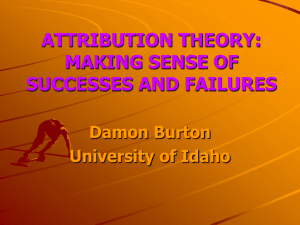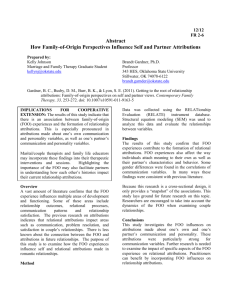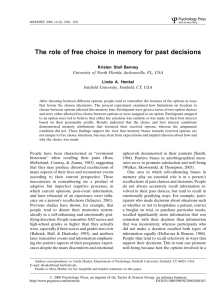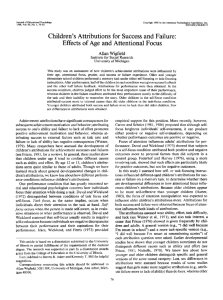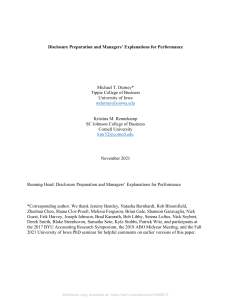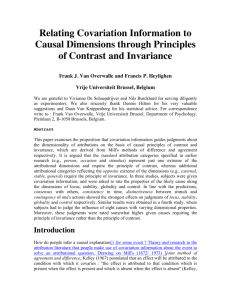ED 300 Ch 11 Motivation and Affect - Moroni-ITEP
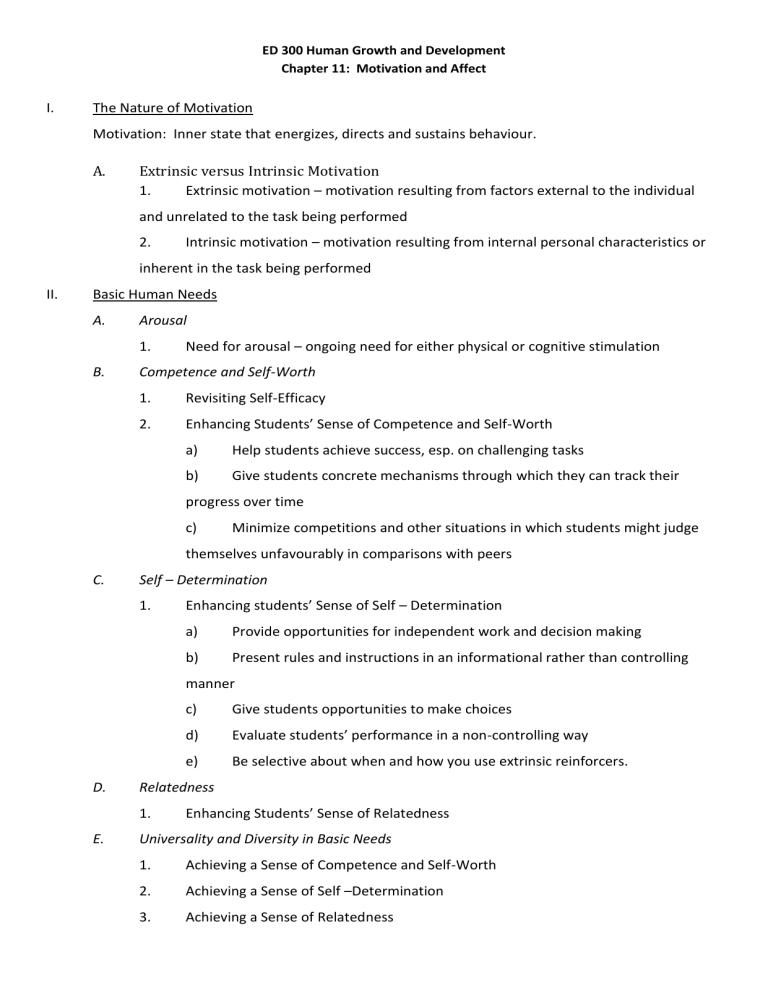
I.
The Nature of Motivation
ED 300 Human Growth and Development
Chapter 11: Motivation and Affect
Motivation: Inner state that energizes, directs and sustains behaviour.
A.
Extrinsic versus Intrinsic Motivation
1.
Extrinsic motivation – motivation resulting from factors external to the individual and unrelated to the task being performed
2.
Intrinsic motivation – motivation resulting from internal personal characteristics or inherent in the task being performed
II.
Basic Human Needs
A.
Arousal
1.
Need for arousal – ongoing need for either physical or cognitive stimulation
B.
Competence and Self-Worth
1.
Revisiting Self-Efficacy
2.
Enhancing Students’ Sense of Competence and Self-Worth a) Help students achieve success, esp. on challenging tasks b) Give students concrete mechanisms through which they can track their progress over time c) Minimize competitions and other situations in which students might judge themselves unfavourably in comparisons with peers
C.
Self – Determination
1.
Enhancing students’ Sense of Self – Determination a) Provide opportunities for independent work and decision making b) Present rules and instructions in an informational rather than controlling manner c) Give students opportunities to make choices d) Evaluate students’ performance in a non-controlling way e) Be selective about when and how you use extrinsic reinforcers.
D.
Relatedness
1.
Enhancing Students’ Sense of Relatedness
E.
Universality and Diversity in Basic Needs
1.
Achieving a Sense of Competence and Self-Worth
2.
Achieving a Sense of Self –Determination
3.
Achieving a Sense of Relatedness
F.
A Possible Hierarchy of Needs: Maslovw’s Theory
1.
Physiological. Needs related to physical survival (food, water, oxygen, warmth, etc.)
2.
Safety. Need to feel safe & secure in one’s environment
3.
Love and belonging. Need to be have affectionate relationships with others
4.
Esteem. Feel good about oneself – self-esteem
5.
Self-actualization. Need to reach one’s full potential – become all that one is capable of becoming
III.
Cognitive Factors in Motivation
A.
Interests
1.
Promoting Interest in Classroom Subject Matter
B.
Expectancies and Values
1.
Internalizing Cultural Values over the Course of Development a) Engage and model b) Provide, responsive and support environment c) Offer autonomy in decision making d) Set reasonable limits for behaviour & provide information on why certain behaviours are important
2.
Fostering Expectancies and Values in the Classroom a) Convey how concepts & principles help students b) Relate information and skills to students’ present concerns and long-term goals c) Clearly identify particular knowledge & skills students will gain from lessons d) Embed the use of new skills within the context of meaningful, real-world tasks e) Model f) benefit
Refrain from asking students to engage in activities with the long term
C.
Goals
1.
Achievement Goals a) Effects of Mastery and Performance goals b) Developmental Trends in Achievement Goals
(1) Common practices:
(a) Reinforcing students only for correct answers
(b) Posting only the ‘best’ work on a bulletin board
(c) Grading test on a curve
c)
(d) Reminding students of the importance of good grades for college admissions
(e) Giving special recognition to sports teams that consistently defeat their rivals
Fostering Productive Achievement Goals
(1) Show how mastery of certain topics is relevant to students’ long-term personal and professional goals
(2) Communicate the belief that effective learning requires exerting effort and making mistakes
(3) Give students short-term, concrete goals – proximal goals
(4) Ask them to set own proximal goals
(5) Provide regular feedback so students assess their progress toward goals
(6) Offer specific suggestions about how students can improve
(7) Give praise
(8) Encourage students to use their peers as a source of ideas and assistance
2.
Work-Avoidance Goals
3.
Social Goals
4.
Career Goals
5.
Coordinating Multiple Goals
D.
Attributions
1.
How Attributions Influence Affect, Cognition and Behavior
2.
Developmental Trends in Attributions
3.
Mastery Orientation versus Learned Helplessness
E.
F.
Teacher Expectations and Attributions
1.
How Teacher Expectations and Attributions Affect Students’ Achievement
Diversity in Cognitive Factors Affecting Motivation
1.
Cultural and Ethnic Differences
2.
Gender Differences
3.
Socioeconomic Differences
IV.
Affect and Its Effects
A.
How Affect and Motivation are interrelated
B.
How Affect is Related to Learning and Cognition
C.
Anxiety in the Classroom
1.
How Anxiety Affects Learning and Performance
2.
Sources of Anxiety a) Situation in which physical safety is at risk b) Self-worth is threatened c) New situation eg movement from schools d) Judgment or evaluation by others eg teacher lower grade or peers hate or disliked e) Frustrating subject matter – f) Excessive classroom demand g) Classroom test h) Concern about the future
3.
Making the transition to a Secondary School Format
4.
Keeping Students’ Anxiety at a Facilitative Level a) Communicate clear, concrete and realistic expectations for performance b) Match instruction to students’ cognitive levels and capabilities c) When students have a high level of trait anxiety, provide considerable structure to guide their activities d) Provide supplementary sources of support for learning challenging topics, skills until mastery is attained e) Teach strategies that can enhance students’ learning and performance f) Assess students’ performance independently of how well their classmates are doing and encourage students to assess their own performance in a similar manner g) Provide feedback about specific behaviours, rather than global evaluations of classroom performance h) Allow students to correct errors so that no single mistake is ever a ‘fatal’ one
D.
Diversity in Affect
1.
Cultural and Ethnic Differences
2.
Gender Differences
3.
Socioeconomic Differences
V.
The Big Picture
A.
All children and adolescents are motivated in one way or another
B.
Motivation to do well in school is grounded in a variety of cognitive factors that build up slowly over time
C.
Conditions in the classroom play a major role in students’ motivation to learn and achieve
